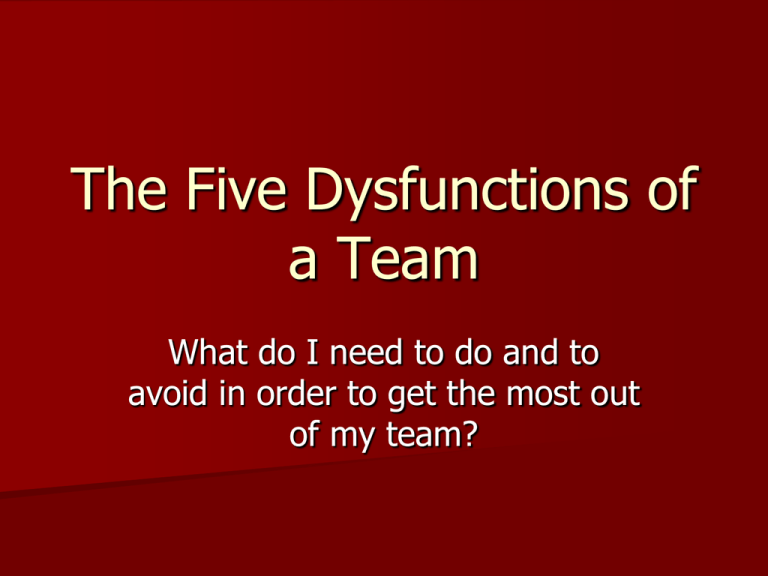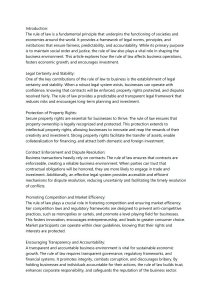The 5 Dysfunctions of a Team
advertisement

The Five Dysfunctions of a Team What do I need to do and to avoid in order to get the most out of my team? Inattention to results Avoidance of accountability Lack of commitment Fear of conflict Absence of trust Absence of Trust We want to be invulnerable Therefore, we do not expose our weaknesses Thus, we are not honest It is impossible to build trust without honesty In many cases, we are almost conditioned to “keep our guard up” In our society exposing weakness is frowned upon What happens when there is an absence of trust? Low Morale How do we go about building trust in a team setting? Personal histories exercise Team effectiveness exercise – Single most important contribution – One area they must change or eliminate for the good of the team Personality and behavioral preference profiles – Who are we? – Why do we do what we do? 360 Degree Feedback Experiential team exercises What must a leader do in this situation? Display vulnerability first and make sure it is genuine. Fear of Conflict If trust is not present, people will not engage one another – Artificial harmony – Important decisions will not be made – People become angry Conflict can be good – If it is ideologically based – If it avoids personalityfocused, mean-spirited attacks – Teams generally avoid this to spare one another’s feelings This leads to increased tension! How do we create good conflict? Mining – Extract buried disagreements and shed light on them – Call out sensitive issues and force team to work through them Real-time permission – When people appear to be uncomfortable, let them know that what they are doing is good What must a leader do in this situation? A leader must allow conflict to take place. A leader should model appropriate conflict behavior and allow resolution to occur naturally. Lack of Commitment People become ambiguous People will not buy-in if they do not have an opportunity to weighin Failure to achieve buy -in from the “first team” filters down The two greatest causes are: – Desire for consensus – The need for certainty Desire for consensus Complete agreement is often not possible, but buy-in is always possible Reasonable people do not need to “get their way” in order to support a decision, but they do need to have their opinion or option considered You must consider all opinions If your group is at an impasse, the leader makes the call The need for certainty A decision is better than no decision Waffling is worse than making a bold decision that later proves to be wrong You can always change course Delaying decisions leads to paralysis and loss of confidence How do we go about getting people to commit? Cascading messaging – Review key decisions – Agree on what needs to be communicated – Reduces fears – Illustrates that bad decisions are “survivable” Deadlines – Ensures that misalignment is identified and addressed Contingency and worse-case scenario analysis Low risk exposure therapy – Force your team to make decisions What must a leader do in this situation? A leader must be comfortable making a decision that turns out to be wrong. A leader must push the group for closure around issues and adherence to schedule. Avoidance of Accountability People do this to avoid uncomfortable situations This is really difficult in peer-to-peer situations No buy-in, no accountability You need team members willing to call their peers on performance or behaviors that might hurt the team The closer the team members, the greater the danger How do we foster accountability? Publicize your goals and standards – Provides clarity about what is expected – Eliminates ambiguity Simple and regular progress reviews – Are we on the right track? – Allows people to get back on track Team rewards – This assists in creating a culture of accountability – Team members are more likely to speak up What must a leader do in this situation? A leader must encourage and allow the team to be the first and primary accountability mechanism. However, a leader must be willing to serve as the ultimate arbiter of discipline when the team fails. Inattention to Results Ego and status get in the way – Doing “our job” is not enough – Being part of the team is not enough Goals are not common Negative language – Use we and us instead of you and I Politics – Foster an environment where people can say what they think Lack of focus – A laser-like focus on the objectives and outcomes is required or people revert to individual status or a “just happy to be here” attitude How do we get our team’s focus on results? Public declaration of results – Sometimes saying we will do our best is preparing for failure – What do we intend to do? Results-based rewards – No credit for trying hard What must a leader do in this situation? A leader must set the tone for a focus on results. If the team senses that the leader values anything other than results, they will do the same.






![Action Plan Training for College of Education [Erickson Hall]](http://s3.studylib.net/store/data/006838784_1-e08201da1f024d72d03dde66b95777a5-300x300.png)




